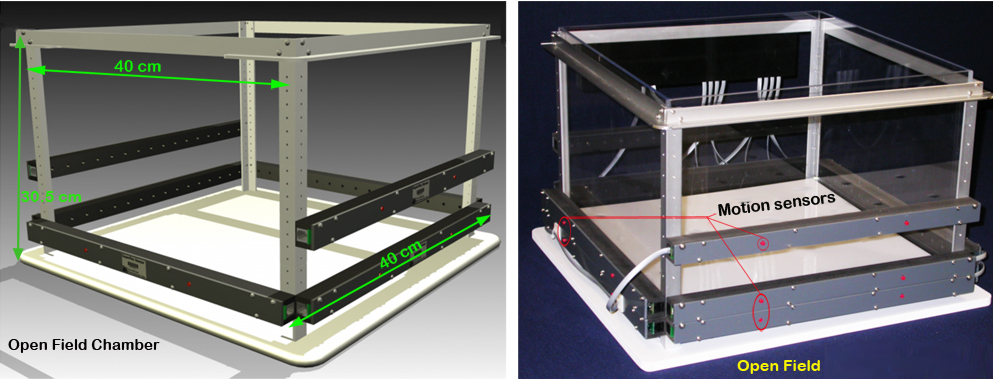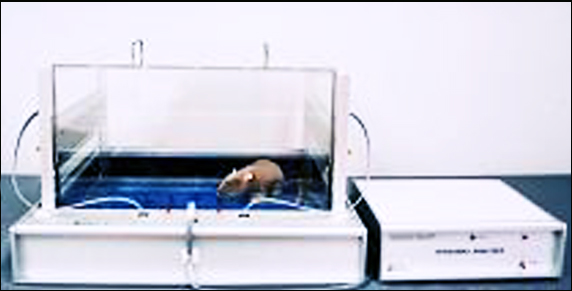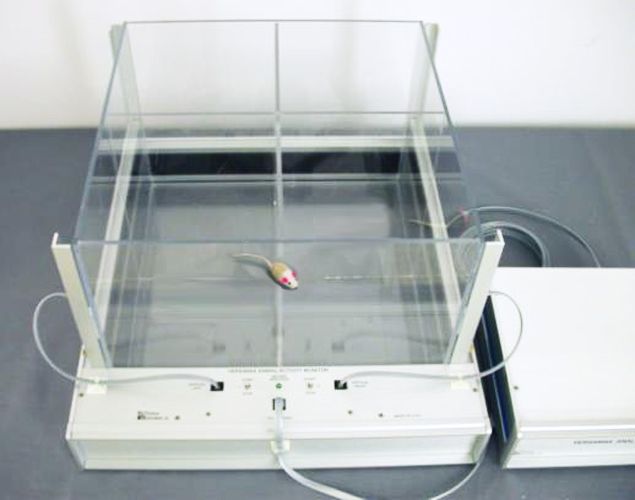Donahue4 project protocol
Behavioral phenotypes of C57BL/6J-Chr#PWD/Ph/ForeJ mouse chromosome substitution strains (2011)
Donahue LWith: Morgan J
Project protocol — Contents
Workflow and sampling
Equipment and supplies
Reagents and solutions
Procedure for conducting open field test
Definitions
Data
ReferencesWorkflow
Mice brought from the mouse room to the test room and acclimated before testing begins After acclimation to testing environment, mice are placed in the center arena of an open field apparatus to measure activity Mice returned to home cages and arena platform cleaned and system re died for the next mouse
- Open field arena made of a clear acrylic (40 X 40 X 30 cm) placed inside a frame containing evenly spaced photocells and receptors making a grid of infrared photobeams from the front to the back and from the left to the right (AccuScan Instruments Inc., Columbus, Ohio)
- Sound attenuating PVC / lexan environmental chamber (Med Associates, Inc.)
- Versamax Software animal activity monitoring system (AccuScan Instruments Inc., Columbus, Ohio), see Fig. 1
- Red 7.5W light bulb
- Ventilation fan
- Cleaning supplies
- Food/reward pellets
- Disinfectant and cleaning solutions
Acclimation to test conditions
Testing is conducted during the light phase between 08:00 and 16:00 h. Mice are transported from the vivarium into the test room and are allowed to habituate for at least 30 min before testing.
Procedure for conducting the open field test
Activity assessment is conducted in 4 square arenas constructed of clear acrylic panels (see Fig. 1 and 2). Mouse activity is measured via a grid of invisible infrared light beams. A number of equally spaced beams traverse the mouse cage front to back and an equal number of beams traverse the same cage from left to right. Any movement made by a mouse within the VersaMax monitor break through these light beams. Thus revealing the mouse’s position in the (X-Y) plane. Vertical sensors monitor rearing and jumping activity. The Versamax software analyzer collects the beam status information from the activity monitor and subjects it to rapid analysis. Each time the analyzer receives the beam status, it is able to determine the position of the mouse at 50 times per second. At this speed stereotypic activity, as well as hyperactivity, where a mouse transverses the entire cage in fractions of a second is readily monitored.
a. Each of the 4 arenas is mounted within specially designed sound attenuating shells constructed of polypropylene and regular and expanded PVC. Besides keeping outside noise to a minimum, these chambers also keep out external light and odors.
b. Before testing the VersaMax monitoring system is automatically checked and configured according to manufacturer's protocol and is illuminated with a red 7.5W light bulb.
c. With the automatic tracking system turned ON, each mouse is placed in the center of the arena (Fig. 3) and allowed to move freely about the novel environment for 10 min (600 s). The VersaMax Analyzer collects the beam status information 50 times per seconds, a speed sufficient to reveal stereotypic activity and hyperactivity
d. At the conclusion of each trial the mouse is temporarily removed from the arena, returned to its holding cage, and the system readied for subsequent testing.
e. In between mice, the surface of the arena is disinfected with 70% ethanol.Definitions & data generated variables
- HACTV: The total number of beam interruptions that occurred in the horizontal sensor during a given sample period.
- TOTDIST: Total distance traveled is not the same as "horizontal activity" counts. If the animal travels from one corner to the diagonally opposite corner, he will generate the same "horizontal activity" count regardless of path traveled. The distance traveled however, is dependent on the path that the animal takes. Hence, "total distance" is a more accurate indicator of ambulatory activity! The number indicates in centimeters the distance traveled by the animal in a given sample period.
- MOVNO: Number of discrete horizontal movements. Each time a break in ambulatory activity occurs for a period greater than 1 s, this variable is incremented by 1. This indicates the number of separate horizontal movements executed by the animal in a given sample period. Individual movements are separated from each other by a rest period of at least 1 s.
- MOVTIME: As long as the animal is ambulating, this variable is incremented. If the animal is non-ambulatory for more than 1 s, this variable is no longer incremented. Thus it corresponds to the amount of time the animal was in ambulation during a given sample period. Does not include stereotypy time.
- RESTIME: It is computed as the difference between sample time and time spent moving.
- VACTV: The total number of beam interruptions that occurred in the vertical sensor during a given sample period.
- VMOVNO: Each time the animal rears up, this variable is incremented by 1. The animal must go below the level of the vertical sensor for at least 1 s before the next rearing can be registered.
- VTIME: When the animal activates the vertical sensor by rearing, this variable starts incrementing and continues to increment until the animal goes below the level of the vertical sensor.
- STRCNT: If the animal breaks the same beam (or set of beams) repeatedly then the monitor considers that the animal is exhibiting stereotypy. This typically happens during grooming, head bobbing, etc. Stereotypy count is the number of beam breaks that occur during this period of stereotypic activity.
- STRNO: This corresponds to the number of times the monitor observed stereotypic behavior in the animal. A break in stereotypy of 1 s or more is required to separate one stereotypic episode from the next.
- STRTIME: The total amount of time that stereotypic behavior is exhibited.
- MRGDIST: The distance (in centimeters) an animal travels while in the margin or corners of the cage.
- MRGTIME: Time spent by the animal in close proximity (within 1 cm) to the walls of the cage
- CTRDIST: The distance (in centimeters) an animal travels while in the center of the cage.
- CTRTIME: Time spent by the animal away from the walls of the cage.
Data collected by investigator
- horizontal activity
- beam breaks
- episodes
- duration
- vertical activity
- beam breaks
- episodes
- duration
- distance traveled
- center
- total
- stereotypy (repetitive behavior)
- beam breaks
- episodes
- duration
- thigmotaxis
- duration
- distance traveled


